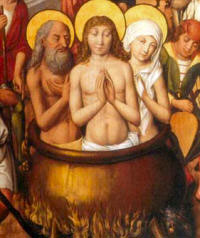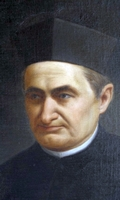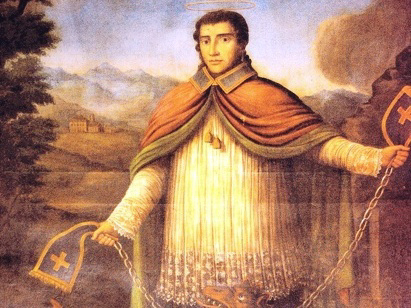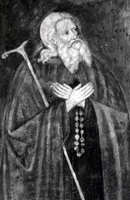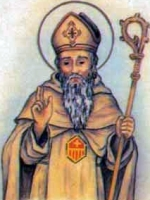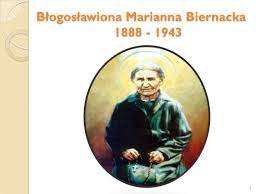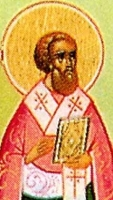St. Dulas
Feastday: June 15
Death: 310
Martyr from Zephyrium, Cilicia, he called Tatian Dulas in some lists. He was arrested and refused to worship Apollo and other Roman gods. Tortured, Dulas died while being taken to Tarsus.
St. Aleydis
புனித ஆலிஸ் (1220-1250)
இவர் பெல்ஜியத்தில் உள்ள ஷேர்பெக் என்ற இடத்தில் பிறந்தார்.
தன்னுடைய ஏழாவது வயதிலேயே சிஸ்டர்சியன் துறவிகள் மடத்தில் சேர்ந்த இவர், அங்கேயே தன்னுடைய கல்வியைக் கற்கத் தொடங்கினார். கல்வியில் சிறந்து விளங்கிய இவர், தாழ்ச்சியோடும் இருந்தார.
இவருக்கு 20 ஆவது வயது நடக்கும்பொழுது தொழுநோயால் பாதிக்கப்பட்டார். அதனால் இவர் தனிமைப்படுத்தப்பட்டார். தொழுநோயால் இவர் துன்பங்களை அனுபவித்துக் கொண்டிருந்த அதே வேளையில், கண்பார்வையையும் இழந்தார். இதனால் இவர் அடைந்த துயருக்கு அளவே இல்லை.
இப்படிப்பட்ட சூழ்நிலையில் இவர் நற்கருணை ஆண்டவர்மீது மிகுந்த பற்றுக் கொள்ளத் தொடங்கினார். அந்தப் பற்று இவருக்கு ஆறுதலையும் அரவணைப்பையும் நம்பிக்கையையும் தந்தது. சில நேரங்களில் நற்கருணை ஆண்டவர் இவருக்குக் காட்சி தந்து இவரைத் திடப்படுத்தினார்.
நாள்கள் செல்ல செல்ல இவருடைய உடலில் வேதனை மிகுதியானது. இதனால் இவர் தன்னுடைய முப்பதாவது வயதில் உடல்நலம் குன்றி இறையடி சேர்ந்தார்.
இவருக்கு 1907 ஆம் ஆண்டு திருத்தந்தை பத்தாம் பயஸால் புனிதர் பட்டம் கொடுக்கப்பட்டது. இவர் பார்வையற்றவர்கள், முடக்குவாதத்தால் பாதிக்கப்பட்டவர்கள் ஆகியோருக்குப் பாதுகாவலராக இருக்கிறார்
Feastday: June 15
Patron: The Blind, the Paralysed
Birth: 1204
Death: 1250
Aleydis or Adelaide, Virgin. She was born at Shaerbeck, near Brussels. At the age of seven, she entered a Cistercian convent named Camera Sanctae Mariae, and she remained there for the rest of her life.
The Cistercian community was inspired by her spirit of humility. However, at an early age, she contracted leprosy and had to be isolated. The disease caused Aleydis intense suffering, and eventually she became paralyzed and was afflicted with blindness.
Aleydis' greatest consolation came from reception of the Holy Eucharist, although she was not allowed to drink from the cup because of the danger of contagion. However, the Lord appeared to her with assurance that to receive under one species, was sufficient. Known for visions and ecstasies, she died in 1250. Devotion to her was approved in 1907 by Pope Pius X.
There is much sickness and related suffering in the world today. Like St. Aleydis, we must try to turn our suffering into good and pray that God will give us the strength to endure and that we may be consoled through the reception of the Sacraments.
Alice was born at Shaerbeck, near Brussels. At the age of seven, she entered a Cistercian convent named Camera Sanctae Mariae, and she remained there for the rest of her life. The Cistercian community was inspired by her spirit of humility. However, at an early age, she contracted leprosy and had to be isolated. The disease caused Aleydis intense suffering, and eventually she became paralyzed and was afflicted with blindness. Alice's greatest consolation came from reception of the Holy Eucharist, although she was not allowed to drink from the cup because of the danger of contagion. However, the Lord appeared to her with assurance that to receive under one species, was sufficient. Known for visions and ecstasies, she died in 1250. Devotion to her was approved in 1907 by Pope Pius X.
There is much sickness and related suffering in the world today. Like St. Alice, we must try to turn our suffering into good and pray that God will give us the strength to endure and that we may be consoled through the reception of the Sacraments.
Bls. Thomas Green, Thomas Scryven, and Thomas Reding
Feastday: June 15
Death: 1537
English Carthusian martyrs. Thomas Green studied at St. John's College, Cambridge, entering the London Charterhouse of the Carthusians where he took vows and received ordination. Arrested for opposing King Henry VIII's (r. 1509-1547) claim of spiritual supremacy over the English Church, Thomas was imprisoned with two other Carthusians, the lay brothers Thomas Scryven and Thomas Reding, and four other companions. All were starved to death at Newgate.
"Martirio de los cartujos de Mauerbach" (Martyrdom of the Mauerbach Carthusians) Vicente Carducho. 1642
The Carthusian martyrs are those members of the Carthusian monastic order who have been persecuted and killed because of their Christian faith and their adherence to the Catholic religion. As an enclosed order the Carthusians do not, on principle, put forward causes for their members, though causes have been promoted by others on their behalf.
The order
The Carthusian order was founded in 1084 by St. Bruno of Cologne, and is an eremitic order, holding to the principle of withdrawal from the world to a life of silent contemplation and prayer. They are often viewed as hermits that live in common, having no active apostolate outside their Charterhouse. Carthusian life is dramatically different as compared to Benedictine Monasticism, the most prevalent form in the west. Today the Carthusians are a small order comprising 25 houses worldwide with just 350 male and 75 female members.
The Martyrs
During the Hussite Revolution in Bohemia in the 15th century Carthusian houses, as with other Catholic institutions, came under attack. In 1419 the charterhouse in Prague was burned down.[1]
Dom Andreas, prior of Žiče Charterhouse, was captured during an Ottoman raid and martyred on March 3, 1529.[2] The Mauerbach Charterhouse on the outskirts of Vienna, Austria, was plundered and set on fire by Ottoman troops during the 1529 Siege of Vienna, and was again targeted by the Ottomans during the 1683 Battle of Vienna, though there seems no precise record of the names of monks killed in either assault.
In 1537 during the English Reformation the London Charterhouse was dissolved and its members imprisoned and later executed. Eighteen of these, the Carthusian Martyrs of London, were beatified in 1886 by Pope Leo XIII;[3] three of these (Augustine Webster, John Houghton and Robert Lawrence) were canonized in 1970 by Pope Paul VI with other English martyrs as the Forty Martyrs of England and Wales.
In 1572 during the Dutch Revolt the Charterhouses of Delft and Roermond were attacked, resulting in the deaths of Dom Justus van Schoonhoven and at least two others.[4]
During the French Revolution numerous Carthusians were persecuted with other Catholic religious and lay persons. Claude Beguignot and Lazarus Tiersot were ordained Carthusians. As priests, they were required to take the anti-Papal oath of the "Civil Constitution of the Clergy". At their refusal they were imprisoned along with eight other Carthusians in former slave ships anchored in the Charente River at Rochefort. Like most of 800 priests and clergy confined there, they died in 1794 due to the inhumane conditions.[5] They were beatified by Pope John Paul II in 1995.[6]
In 1936, during the Spanish Civil War, Carthusians were affected by the widespread anti-clericalism; two of these, from the Charterhouse of Montalegre, have so far been recognized.
In September 1944, monks from the charterhouse at Certosa di Farneta opened their doors to troops from the 16th SS Panzergrenadier Division, who said they came bearing gifts for the abbey. They broke into the monastery to arrest 32 partisans and Jews being sheltered in the monastery. Some of the refugees were able to escape. Of the more than sixty killed, twelve were Carthusians.[7] Among the twelve Carthusians killed were two Germans, one Swiss, one Venezuelan, and one Spaniard. The remaining monks were also from diverse countries. Those killed were:
Benedetto Lapuente,
Bruno D'Amico,
Raffaele Cantero,
Adriano Compagnon,
Adriano Clerc,
Michele Nota,
Giorgio Maritano,
Pio Egger,
Martino Binz,
Gabriele Maria Costa,
Bernardo Montes de Oca
Aldo Mei
St. Crescentia
Feastday: June 15
Patron: actors; comedians; Czechoslovakia; dancers; dogs; epilepsy; Mazara del Vallo, Sicily; Forio, Ischia; oversleeping; Prague, Czech Republic; rheumatic chorea (Saint Vitus Dance); snake bites; storms; Vacha, Germany; Zeven, Lower Saxony; E Clampus Vitus
St. Crescentia, Vitus and Modestus were Christians who gave their live for the Faith in the Roman province of Lucania, in southern Italy. Crescentia was Vitus' attendant. They were racked on the iron horse until their limbs were dislocated. At this juncture, a great storm arose which destroyed many temples, killing a multitude of pagans. An angel now descended from heaven, set the martyrs free, and led them back to Lucania, where they peacefully expired, worn out by their sufferings. Their feast day is June 15th.
"Saint Vitus" redirects here. For the doom metal band, see Saint Vitus (band). For music venue, see Saint Vitus (venue). For other uses, see Saint Vitus (disambiguation).
"Saint Guy" redirects here. For the Belgian saint, see Guy of Anderlecht.
"Vít" redirects here. For other uses, see VIT (disambiguation).
For other uses, see Vitus (disambiguation).
Vitus (/ˈvaɪtəs/), whose name is sometimes rendered Guy or Guido, was a Christian martyr from Sicily. His surviving hagiography is pure legend. The dates of his actual life are unknown.[1][2] He has for long been tied to the Sicilian martyrs Modestus and Crescentia but in the earliest sources it is clear that these were originally different traditions that later became combined.[3] The figures of Modestus and Crescentia are probably fictitious.[1]
According to his legend, he died during the Diocletianic Persecution in AD 303. In the Middle Ages, he was counted as one of the Fourteen Holy Helpers. In Germany, his feast was celebrated with dancing before his statue. This dancing became popular and the name "Saint Vitus Dance" was given to the neurological disorder Sydenham's chorea. It also led to Vitus being considered the patron saint of dancers and of entertainers in general.[4] He is also said to protect against lightning strikes, animal attacks and oversleeping. His feast day is celebrated on 15 June. In places where the Julian calendar is used, this date coincides, in the 20th and 21st centuries, with 28 June on the Gregorian calendar.
The martyrdom of Vitus, Modestus, and Crescentia, from a fourteenth-century manuscript
According to the legend, Vitus, Modestus and Crescentia were martyrs under Diocletian. The earliest testimony for their veneration is offered by the "Martyrologium Hieronymianum" (ed. G. B. de Rossi-Louis Duchesne, 78: "In Sicilia, Viti, Modesti et Crescentiae"). The fact that the note is in the three most important manuscripts indicates that it was also in the common exemplar of these, which appeared in the fifth century. The same Martyrologium has under the same day another mention of a Vitus at the head of a list of nine martyrs, with the statement of the place, in Eboli, "In Lucania", that is, in the Roman province of that name in southern Italy between the Tuscan Sea and the Gulf of Taranto. It is easily possible that it is the same martyr Vitus in both cases.
According to J. P. Kirsch,[5] the testimony to the public veneration of the three saints in the fifth century proves that they are historical martyrs. There are, nevertheless, no historical accounts of them, nor of the time or the details of their martyrdom.
During the sixth and seventh centuries a purely legendary narrative of their martyrdom appeared which appears to be based upon other legends, especially on the legend of Potitus, and ornamented with accounts of fantastic miracles. According to this legend, which has no apparent historical value, Vitus was a 7-year-old son of a senator of Lucania (some versions make him 12 years old). He resisted his father's attempts, which included various forms of torture, to make him turn away from his faith. He fled with his tutor Modestus and Modestus's wife Crescentia, who was Vitus's nanny, to Lucania. He was taken from there to Rome to drive out a demon which had taken possession of a son of the Emperor Diocletian. He successfully performed the exorcism, but, because he stayed faithful to Christianity, he and his tutors were tortured. By a miracle an angel brought back the three to Lucania, where they died from the tortures they had endured. Three days later, Vitus appeared to a distinguished matron named Florentia, who then found the bodies and buried them where they lay.
Veneration
The veneration of the martyrs spread rapidly in Southern Italy and Sicily, as is shown by the note in the "Martyrologium Hieronymianum". Pope Gregory the Great mentions a monastery dedicated to Vitus in Sicily ("Epist.", I, xlviii, P.L., LXXXVII, 511).
The veneration of Vitus, the chief saint of the group, also appeared very early at Rome. Pope Gelasius I (492-496) mentions a shrine dedicated to him (Jaffé, "Reg. Rom. Pont.", 2nd ed., I, 6 79), and at Rome in the seventh century the chapel of a deaconry was dedicated to him ("Liber Pont.", ed. Duchesne, I, 470 sq.).
In AD 756, Abbot Fulrad is said to have brought the relics of St. Vitus to the monastery of St-Denis. They were later presented to Abbot Warin of Corvey in Germany, who solemnly transferred some of them to this abbey in AD 836. From Corvey the veneration of St Vitus spread throughout Westphalia and in the districts of eastern and northern Germany. His popularity grew in Prague, Bohemia when, in AD 925, king Henry I of Germany presented as a gift the bones of one hand of St. Vitus to Wenceslaus, Duke of Bohemia. Since then, this relic has been a sacred treasure in the St. Vitus Cathedral in Prague.
The veneration of St. Vitus became very popular in Slavic lands, where his name (Sveti Vid) may have replaced more ancient worship of the god of light Svetovid.[6]
In Serbia his feast day, known as Vidovdan, is of particular historical importance.[7] The day is part of the Kosovo Myth — the Battle of Kosovo occurred on that day; several events have symbolically occurred on that day, such as the 1914 assassination of the Austrian royal couple; Vitus was the patron saint of the Kingdom of Serbia.[8] In Hungary he has been venerated as Szent Vid since the early Middle Ages. In Bulgaria, it is called Vidovden (Видовден) or Vidov Den (Видов ден) and is particularly well known among the Shopi, in the western part of the country. In Croatia, 123 churches are dedicated to St. Vitus.
In the Netherlands, Vitus is the patron saint of Winschoten, as well as of the region of the Gooi, where in each of the three largest towns (Hilversum, Bussum and Naarden), the main Catholic Church is dedicated to St Vitus.
Vitus is one of the Fourteen Martyrs who give aid in times of trouble. He is specifically invoked against chorea, which is called St. Vitus Dance.
He is represented as a young man with a palm-leaf, in a cauldron, sometimes with a raven and a lion, his iconographic attribute because according to the legend he was thrown into a cauldron of boiling tar and molten lead, but miraculously escaped unscathed.
The names of Saints Modestus and Crescentia were added in the 11th century to the Roman Calendar,[9] so that from then on all three names were celebrated together until 1969, when their feast was removed from the General Roman Calendar. Vitus is still recognized as a saint of the Catholic Church, being included in the Roman Martyrology under 15 June,[10] and Mass may be celebrated in his honor on that day wherever the Roman Rite is celebrated,[11] while Modestus and Crescentia, who are associated with Vitus in legend, have been omitted, because they appear to be merely fictitious personages.
Saint Germaine Cousin
புனிதர் ஜெர்மைன் கஸின்
(St. Germaine Cousin)
ஃபிரெஞ்ச் புனிதர்:
(French Saint)
பிறப்பு: கி.பி. 1579
பைப்ரேக், டௌலோஸ், ஃபிரான்ஸ்
(Pibrac, Toulouse, France)
இறப்பு: கி.பி. 1601
பைப்ரேக், டௌலோஸ், ஃபிரான்ஸ்
(Pibrac, Toulouse, France)
ஏற்கும் சமயம்:
ரோமன் கத்தோலிக்க திருச்சபை
(Roman Catholic Church)
முக்திபேறு பட்டம்: மே 7, 1864
திருத்தந்தை ஒன்பதாம் பயஸ்
(Pope Pius IX)
புனிதர் பட்டம்: ஜூன் 29, 1867
திருத்தந்தை ஒன்பதாம் பயஸ்
(Pope Pius IX)
முக்கிய திருத்தலம்:
பைப்ரேக்
(Pibrac)
நினைவுத் திருநாள்: ஜூன் 15
பாதுகாவல்:
கைவிடப்பட்ட மக்கள் (Abandoned People), துஷ்பிரயோகம் செய்யப்பட்டவர்கள் (Abuse Victims), வறுமைக்கு எதிரானக (Against Poverty), ஊனமுற்றோர் (Disabled People), கிராமப்புற பெண்கள், (Girls from Rural Areas), நோய் (Illness), வறிய நிலை (Impoverishment), பெற்றோரை இழந்தோர் (Loss of Parents), உடல் பயிற்சி சிகிச்சையாளர்கள் (Physical Therapists)
புனிதர் ஜெர்மைன் கஸின், ஒரு ஃபிரெஞ்ச் புனிதர் ஆவார். ஃபிரான்ஸ் நாட்டின் “டௌலோஸ்” (Toulouse) நகரிலிருந்து 15 கிலோமீட்டர் தூரத்திலுள்ள “பைப்ரேக்” (Pibrac) எனும் கிராமத்தில் மிகவும் தாழ்ச்சியுள்ள பெற்றோருக்குப் பிறந்தவர்.
கத்தோலிக்க கலைக்களஞ்சியம் (Catholic Encyclopedia) இவரைப்பற்றி பின்வருமாறு எழுதுகிறது:
“தமது பிறப்பு முதலே எண்ணற்ற துன்பங்களை அனுபவித்தவராக இவர் குறிப்பிடப்படுகிறார். இவர் பிறக்கும்போதே ஒரு கை சிதைந்த நிலையிலும், “ஸ்க்ரோஃபுலா” (Scrofula) எனப்படும் காசநோய் சம்பந்தமான ஒரு நோயுடனும் பிறந்தார். இவர் கைக்குழந்தையாக இருக்கும்போதே தமது தாயை இழந்தார். இவரது தந்தை விரைவிலேயே மறுமணம் செய்துகொண்டார். புதிதாக வந்த மாற்றான்தாய் இவரை கொடுமைப்படுத்தினார். ஜெர்மைனுடைய நோயிலிருந்து பிற குழந்தைகளை பாதுகாப்பதாக பாசாங்கு செய்த மாற்றான்தாய், ஜெர்மைனை வீட்டிலிருந்து விலக்கி வைக்க தந்தையின் சம்மதம் பெற்றார். ஆகவே, ஜெர்மைன் குழந்தை பருவத்திலிருந்தே கால்நடை மேய்க்கும் பணியைச் செய்தார். இரவில் களைத்துப்போய் வீடு திரும்பினால் அவரது படுக்கை குப்பைகளாக இருக்கும் அல்லது ஈரமாக இருக்கும். இதுபோன்ற நடைமுறைகளால் குழந்தைப் பருவத்திலிருந்தே தாழ்ச்சியையும், பொறுமையையும் கற்றுக்கொண்டார். கடவுளின் பிரசன்னத்தின் அதிசய உணர்வுகளும் ஆன்மீக ஈடுபாடுகளும் பிறப்பு முதலே அவருக்கு இறை பரிசாக அளிக்கப்பட்டிருந்தன. இவையனைத்துமே இப்புனிதரது தனிமையான வாழ்க்கையின் ஒளி மற்றும் ஆசீர்வாதங்களின் ஆதாரமாக விளங்கின. வறுமை, நலிந்த மற்றும் தளர்ந்த உடல் நிலை, காலத்தின் கடுமையான பருவ மாற்றங்கள், பாசமும் அனுசரணையும் இல்லாத சொந்த குடும்பத்தினர், ஆகியவற்றுடன் தாமாகவே தேடி பெற்றுக்கொண்ட துன்பங்களும் தாழ்ச்சியுடனும் இன்னும் அதிக வேதனைகளைத் தந்தன. தினசரி உணவாக சாதாரண ரொட்டி மற்றும் தண்ணீர் ஆகியவற்றையே வழக்கமான உணவாக ஏற்றுக்கொண்டார். ஆசீர்வதிக்கப்பட்ட தூய நற்கருணையிலுள்ள இயேசு மீதும் அவரது கன்னித்தாய் மீதும் அவர் கொண்டிருந்த மாறாத அன்பு இவரது புனிதத் தன்மையை இன்னும் அதிகரித்தது. திருப்பலியில் தினமும் ஆர்வமுடன் கலந்துகொள்வார். ஆலய மணியோசை கேட்டதுமே தமது மந்தையை அப்படியே மேய்ச்சல் நிலத்தில் விட்டுவிட்டு திருப்பலியில் கலந்துகொள்ள ஓடுவார். கிட்டத்தட்ட ஓநாய் போன்ற காட்டு மிருகங்கள் உலவும் வனாந்தரங்களின் அருகில் மேய்ச்சல் நிலம் இருந்தும் என்றுமே அவரது மந்தைக்கு யாதொரு ஆபத்தும் ஏற்பட்டதில்லை.”
பாவச் செயல்களை சரி செய்யும் முயற்சியாக அவர் முன்னெடுத்த தவ முயற்சிகளும் அடிக்கடி நற்கருணை ஆராதனைகளில் அவர் பங்கெடுத்தமையும் குறிக்கத்தக்கது. மரியன்னையின் மீதுள்ள அவரது பக்தியும் அதிகரித்துக்கொண்டு போனதும் குறிப்பிடத்தக்கது. ஜெபமாலை மட்டுமே அவரது ஒரே புத்தகமாயிருந்தது. இயேசு மீதும் அவரது அதி தூய கன்னித் தாயின் மீதும் அவர் கொண்ட பக்தியும், அன்பும் அளவிட இயலாததும், குறிப்பிடத்தக்கதுமாகும். திருப்பலிக்கான முதல் ஆலய மணியோசை கேட்டதுமே எங்கிருந்தாலும் முழங்கால்படியிட்டு சிலுவை அடையாளமிடுவது அவரது குறிப்பிடத்தக்க கிறிஸ்தவ உயர் பண்பாகும்.
ஆழமற்ற நதியோரங்களிலும், அடை மழையின் பின்னும் அல்லது உறைபனி உருகும் காலங்களிலுமாக அல்லது சீரற்ற அனைத்து காலங்களிலும் அவரது பக்திமயமான தவ வாழ்க்கை சீராக இருந்தது. எழைகளின்பால் அவர் கொண்ட அன்பும் அக்கறையும் இன்னும் அதிகரித்தது. தமக்கு கிடைத்த உலர்ந்த ரொட்டியையும் பிறருடன் பகிர்ந்து உண்ணும் அவரது தாராள, உதார குணம் மிகவும் உயர்வானது.
கி.பி. 1601ம் ஆண்டின் கோடை காலத்தின் ஆரம்பத்தில் ஒருநாள் அதிகாலை, திராட்சைக் கொடிகளால் வேயப்பட்ட தட்டி (Pallet of Vine-Twigs) படுக்கையிலிருந்து எழுந்திருக்காததை கவனித்த இவரது தந்தை, இந்த இருபத்திரண்டு வயது புனிதர் விழிக்காமலேயே நித்திய வாழ்வை நோக்கிச் சென்றிருந்ததைக் கண்டார்.
Also known as
• Germaine of Pibrac
• Germana...
Profile
Daughter of Laurent Cousin, a farm worker, and Marie Laroche. Her mother died while Germaine was an infant. A sickly child, Germaine suffered from scrofula, and her right hand was deformed. Ignored by her father and abused by her step-family, she was often forced to sleep in the stable or in a cupboard under the stairs, was fed on scraps, beaten or scalded with hot water for misdeeds, real or imagined.
At age nine Germaine was put to work as a shepherdess, where she spent much time praying, sometimes using a rosary she made from a knotted string. She refused to miss Mass, and if she heard the bell announcing services, she set her crook and her distaff in the ground, declared her flock to be under the care of her guardian angel, and went to church; her sheep were unharmed during her absences. It is reported that once she crossed the raging Courbet River by walking over the waters so she could get to church.
Germaine was so poor it is hard to imagine she would be able to help others, but she was always ready to try, especially children whom she gathered in the fields to teach a simple catechism and share the little food she had. The locals laughed at her religious devotion, and called her 'the little bigot'.
Once in winter, her stepmother, Hortense, accused her of stealing bread by hiding it in her apron, and threatened to beat her with a stick. Germaine opened her apron, and summer flowers tumbled out. Her parents and neighbors were awed by the obvious miracle, and began to treat her as a holy person. Her parents invited her to rejoin the household, but Germaine chose to live as she had.
In 1601 she was found dead on her straw pallet under the stairs, and she was buried in the Church of Pibrac opposite the pulpit. When accidentally exhumed in 1644 during a renovation, her body was found incorrupt. In 1793 the casket was desecrated by an anti-Catholic tinsmith named Toulza, who with three accomplices took out the remains and buried them in the sacristy, throwing quick-lime and water on them. After the French Revolution, her body was found to be still intact save where the quick-lime had done its work.
Documents attest to more than 400 miracles or extraordinary graces received through the intervention of Saint Germain. They include cures of every kind (of blindness, both congenital and resulting from disease, of hip and of spinal disease), and the multiplication of food for the distressed community of the Good Shepherd at Bourges, France in 1845.
Born
1579 at Pibrac, France
Died
• 1601 in her parents' home in Pibrac, France, apparently of natural causes
• relics interred in the church at Pibrac
Canonized
29 June 1867 by Pope Blessed Pius IX
Saint Luigi Maria Palazzolo
Also known as
Palazzolino (childhood nickname)
Additional Memorial
22 May (Diocese of Bergamo, Italy; Poverelle Sisters, based on the date of founding of the Sisters)
Profile
Youngest of eight boys born to Octavius and Theresa Antoine Palazzolo; his father died when Luigi was about 10 years old. Ordained a priest in the diocese of Bergamo, Italy on 23 June 1850. As a parish priest, he would occasionally encounter children who were abandoned or orphaned and living on their own; he would take them in and care for them until he could get them placed somewhere caring and safe. He founded the Little House of Divine Providence to care for neglected children, and the Work of Saint Dorothy home to care for abandoned girls. Founded the Brothers of the Sacred Family, a congregation that died out in 1928. With Venerable Maria Teresa Gabrieli, he founded the Sisters of the Poor (Poverelle Sisters; Palazzolo Institute) on 22 May 1869 to care for and educate neglected girls; the Sisters received papal approval from Pope Pius X on 25 May 1912, and continue their good work today in Brazil, Burkina Faso, Congo, Italy, Ivory Coast, Kenya, Malawi, Peru and Switzerland. Founded an orphanage in Traona, Italy on 4 October 1872. Due to respiratory problems, Father Luigi had to sleep sitting up during the last year or so of his life.
Born
10 December 1827 in Bergamo, Kingdom of Lombardy-Venetia (in modern Italy)
Died
• in the early hours of 15 June 1886 in Bergamo, Italy of natural causes
• he died murmuring the name "Jesus Christ" over and over
• buried in the cemetery of San Giorgio in Bergamo
• re-interred at the mother-house of the Poverelle Sisters, Via San Bernardino 56, Bergamo, on 4 January 1904
Beatified
• 19 March 1963 by Pope John XXIII
• beatification recognition celebrated in the Basilica of Saint Peter in Rome, Italy
• one of the beatification miracles involved the healing of a young Sardinian woman with peritonitis and tuberculosis on the afternoon of 21 July 1956 when she had a vision of Father Luigi asking her to get out of bed and go to church to thank God for her cure
• another beatification miracle involved the 1959 healing of a 65 year old woman from a severe head injury that left her comatose; the cure followed the family praying for the intercession of Father Luigi
Canonized
• 15 May 2022 by Pope Francis
• the canonization miracle involved the healing of Sister Gianmarisa Perani, who had joined the Poverelle Sisters in 1950; in November 2015 was rushed into emergency surgery, experienced complications, lapsed into a coma, and two months later was declared to be terminal; the Sisters prayed for her, she soon after recovered, and is alive and well today
Patronage
Sisters of the Poor
Saint Vitus
புனிதர் வைட்டஸ்
(St. Vitus)
மறைசாட்சி, தூய உதவியாளர்:
(Martyr, Holy Helper)
பிறப்பு: கி.பி. 290
சிசிலி
(Sicily)
இறப்பு: கி.பி. 303 (வயது 12–13)
லூக்கானியா, தற்போதைய பசிலிகட்டா, இத்தாலி
(Lucania, modern-day Basilica, Italy)
ஏற்கும் சமயம்:
ரோமன் கத்தோலிக்க திருச்சபை
(Roman Catholic Church)
கிழக்கு மரபுவழி திருச்சபை
(Eastern Orthodox Church)
நினைவுத் திருநாள்: ஜூன் 15
பாதுகாவல்:
நடிகர்கள்; நகைச்சுவையாளர்கள்; ரிஜெக்கா (Rijeka), குரோஷியா (Crotia); செக்கோஸ்லோவாக்கியா (Czechoslovakia); நடனக் கலைஞர்கள்; நாய்கள்; வலிப்பு நோய் (Epilepsy); மஸரா டெல் வல்லோ (Mazzara del Vallo), சிசிலி (Sicily); அதிக தூக்கம் (Over Sleeping); ப்ராக் (Prague), செக் குடியரசு (Czech Republic); நரம்பு சம்பந்தமான ஒருவித தசை வலிப்பு நோய் (Rheumatic Chorea); தூய வைட்டஸ் நடனம் (Saint Vitus Dance); செர்பியா (Serbia); பாம்பு கடி (Snake Bites); புயல்கள் (Storms); வாச்சா (Vacha), ஜெர்மனி (Germany); செவன் (Zeven), லோயர் சாக்சனி (Lower Saxony); ஹெட் கூயி (Het Gooi), நெதர்லாந்து (Netherlands); இ க்ளாம்பஸ் வைட்டஸ் (E Clampus Vitus).
புனிதர் வைட்டஸ், கிறிஸ்தவ பாரம்பரியங்களின்படி, சிசிலி நாட்டின் கிறிஸ்தவ புனிதரும் மறைசாட்சியுமாவார்.
இவர், கி.பி. 303ம் ஆண்டு, தூய ரோம பேரரசை ஒன்றாக ஆண்ட இரண்டு பேரரசர்களான (Roman Emperors) “டயாக்லேஷியன்” மற்றும் “மேக்ஸ்மியன்” (Diocletian and Maximian) ஆகியோரின் ஆட்சியில் நடந்த கிறிஸ்தவ துன்புறுத்தல்களின்போது மரித்தவர் ஆவார். ரோமன் கத்தோலிக்க திருச்சபையின் மத்திய காலத்திற்குரிய பதினான்கு தூய உதவியாளர்களில் (One of the Fourteen Holy Helpers) ஒருவராக கொள்ளப்படுகிறார்.
கிறிஸ்தவ பாரம்பரயங்களின்படி, புனிதர்கள் “வைட்டஸ்” (Vitus), “மொடஸ்டஸ்” (Modestus) மற்றும் “கிரெசென்ஷியா” (Crescentia) ஆகிய மூவரும் பேரரசன் “டயாக்லேஷியனால்” (Diocletian) துன்புறுத்தப்பட்டு கொல்லப்பட்டனர்.
Also known as
Guy, Veit, Vith, Vito
Profile
Legend says that Vitus was the son of a pagan Sicilian senator named Hylas. The boy was converted to Christianity at age twelve by his tutor, Saint Modestus, and his nurse Saint Crescentia. His father showed his objection to the conversion by having all three arrested and scourged.
Freed from prison by angels, they fled to Lucania, then Rome. There Vitus freed the son of Emperor Diocletian from an evil spirit. When Vitus would not sacrifice to the pagan gods in celebration, his cure was attributed to sorcery, and he and his household were arrested again. Tortured, and condemned to death, they were thrown to the lions; the lions would not touch them, so they were thrown into boiling oil. At the moment of their deaths, a immense storm destroyed several pagan temples in the region, which led to the tradition of protection against stormy weather. One of the Fourteen Holy Helpers.
For obscure reasons, some 16th century Germans believed they could obtain a year's good health by dancing before a statue of Saint Vitus on his feast day. This dancing developed almost into a mania, and was confused with chorea, the nervous condition later known as Saint Vitus' Dance, the saint being invoked against it. His connection with such "dancing" led to his patronage of dancers, and later to entertainers in general and in particular.
When Vitus was thrown into the oil, a rooster was thrown into the oil with him, sacrificed as part of the ritual against sorcery. A rooster became a symbol for Vitus, and its connection with early rising led to Vitus's patronage and protection against oversleeping.
Died
boiled in oil c.303 in Lucania, Italy
Saint Bernard of Menthon
புனித.பெர்னார்டு (Bernhard of Aosta)
பாதுகாவல்: மலை ஏறுபவர்களுக்கும், ஆல்ப்ஸ் மலைவாழ் மக்களுக்கும
பிறப்பு
923
அவோஸ்டா(Aostatal)
இறப்பு
15 ஜூன் 1008
நோவரா(Novara)
புனிதர்பட்டம்: 1923, திருத்தந்தை 11 ஆம் பயஸ்
இவர் ஓர் சாதாரண குடும்பத்தில் மகனாக பிறந்தார். இவர் இறையியலையும், மெய்யியலையும், திருச்சபை சட்டங்களையும் கற்றுத் தேர்ந்தார். இவரது பெற்றோர் இவரின் கல்லூரி படிப்பை முடித்தபின், பணக்கார பெண்ணிற்கு திருமணம் செய்து வைக்க எண்ணினார். ஆனால் பெர்னார்டு இதை வெறுத்தார். இவரின் மனம் எப்போதும் ஆன்மீக வாழ்வையே நோக்கி சென்றது. இதனால் தன்னுடைய மறைமாவட்ட ஆயர் இல்லத்தில் சேர்ந்து பணியாளராக செயல்பட்டார். இவரின் பணியால் அம்மறைமாவட்ட மக்கள் ஏராளமான பயனை பெற்றனர். இவர் இறக்கும் வரை மறைமாவட்ட குருக்களின் கல்லூரியில் பணியாற்றினார். இவர் 1008 ல் அல்லது 1009 ல் இறந்திருக்கலாம் என்றும் கூறப்படுகின்றது. இவர் நோவரா என்ற ஊரில் அடக்கம் செய்யப்பட்டு, அவர் கல்லறையின் மேல் பேராலயம் ஒன்றும் கட்டப்பட்டுள்ளது. பின்னர் இத்தாலி மற்றும் சுவிட்சர்லாந்திற்கும் இடையில் இவர் நோயாளிகளை பராமரிப்பதற்கென ஓர் இல்லம் தொடங்கினார். நாளடைவில் இவ்வில்லத்தை புனித அகுஸ்தினார் சபையை சார்ந்தவர்கள் கைப்பற்றினர். இப்போது அந்நாடுகளுக்கு சுற்றுலாவிற்கு வரும் மக்கள் அவ்வில்லத்தில் இலவசமாக தங்கி, தங்களின் சுற்றுலாவை மேற்கொள்கின்றனர்.
Also known as
• Apostle of the Alps
• Bernard of Aosta
• Bernard of Aotha
• Bernard of Mentone
• Bernard of Montjoux
Profile
Born to the French nobility. Priest. Archdeacon of Aosta in 996. Evangelized the people of the Alps for over 40 years. Vicar-general of Alpine diocese. He started a patrol that cleared robbers from the mountains, and he established hospices for travellers and pilgrims to Rome, Italy; he established a community of Augustinian Hospitallers to staff them, and they continue their good work today. The large dogs, trained to search for lost victims in the mountains, are named for him.
Born
c.923 at Menthon, Savoy (in modern France)
Died
1008 at Novara, Italy
Canonized
1681 by Pope Innocent XI
Blessed Albertina Berkenbrock
Also known as
• Albertina Serva de Deus
• Albertina, Servant of God
Profile
Lay person in the diocese of Tubarão, Brazil. Raised in a pious family who insured that Albertina had a strong foundation in the faith. Baptized on 25 May 1919, Confirmed on 9 March 1925, and made her First Communion on 16 August 1928. At age 12 she was attacked by one of her father's employees, who tried to rape her. She fought back; when he realized he would fail and she would identify him, the attacker killed Albertina; she is considered a martyr in the defense of chastity.
Born
11 April 1919 in São Luís, Imaruí, Santa Catarina, Brazil
Died
stabbed in the heart with a pen knife during a rape attempt on 15 June 1931 in São Luís, Imaruí, Santa Catarina, Brazil
Beatified
• 20 October 2007 by Pope Benedict XVI
• recognition celebrated by Cardinal José Saraiva Martins in the cathedral of Tubarão, Brazil
Blessed Isfrid of Ratzeburg
Also known as
Isfried, Isfrido
Additional Memorial
17 February in the Diocese of Osnabrück, Germany and the Archdiocese of Hamburg, Germany
Profile
Premonstratensian canon at the Cappenenberg monastery in Westphalia (in modern Germany). Provost of the Premonstratensian house of Jerichow in 1159. Bishop of Ratzeburg, Germany in 1180; he served for 24 years, continued to live by the Premonstratensian rule, and was known for his simple life. He worked to bring the Wends to Christianity. Restored the monastery of Floreffe (in modern Belgium) after it burned, and built many churches throughout the region. Recorded miracles include changing water to wine when needed, and healing a blind man by reciting Scripture over him.
Born
c.1115 in Germany
Died
• 15 June 1204 at Ratzeburg, Holstein, Germany of natural causes
• buried in the choir of the cathedral in Ratzeburg
Beatified
20 March 1728 and 12 April 1728 by Pope Benedict XIII (cultus confirmation)
Saint Hilarion of Espalion
Also known as
• Hilarian of Lévinhac
• Hilarian of Perse
• Ylariano, Hylariano
Profile
Born to the Gallic nobility, he was known as a pious child. Priest in Lévinhac, France. He would often pass through an area of Muslim occupation, cross the River Lot, and celebrate Mass in the town of Perse. Martyr.
Born
c.700 in L•vinhac, France
Died
• beheaded c.793 in Perse, diocese of Rodez, France
• legend says that the body got up, washed the blood off the severated head, and then took it to his mother; he had jokingly promised he would do so every time she nagged him of the danger of passing through Muslim territory to being the Sacraments to the people of Perse
• buried in Lévinhac, France
• relics enshrined in Perse where they are a stop on the route for pilgrims to Santiago de Compostela
Canonized
10 May 1883 by Pope Leo XIII (cultus confirmation)
Saint Landelin of Crespin
Also known as
Landelinus, Lando, Landolin, Landolinus
Profile
Born to the nobility, Landelinus lived for a time as a highway bandit, but repented and became a Benedictine monk. Priest. Founded monasteries in France and Belgium including Lobbes, Beligum in 654; Aulne Abbey, Belgium in 656; Wallers, France in 657; Crespin, France in 670. Worked with Saint Ursmar. Spiritual director of Saint Hadelin of Lobbes and Saint Domitian of Lobbes.
Born
c.625 near Bapaume, France
Died
686 of natural causes
Blessed Pietro Spagnoli
Profile
Pietro became a Gerolamini (Hermits of Saint Jerome) monk as a young man, lived most of his adult life in the Gerolamini house of Montebello, Italy, and later retired from communal life to live as a hermit near Urbino, Italy. He was known as a very pious man, and devotion developed soon after his death.
Born
Urbino, Italy
Died
• 15 June 1415 at the hospice for the sick at the Gerolamini house of San Giovanni Battista near Urbino, Italy of natural causes
• buried under the side altar in the church of San Giovanni Battista the Forerunner
• relics enshrined in a crystal urn under the main altar of the church
Saint Edburgh of Winchester
Also known as
Eadburh, Edburga
Profile
Daughter of King Edward the Elder and Edgiva of Kent; grand-daughter of King Alfred the Great. As a child she was placed in the convent of Nunnaminster, Winchester, England, which King Alfred's widow had founded. She lived her whole life there, a holy nun and abbess.
Died
• 15 June 960 of natural causes
• interred at the Nunnaminster convent, Winchester, England
• some relics translated to Pershore Abbey, Worcestershire, England, which became famous for its miracles
Canonized
972 by Pope John XIII
Saint Eigil of Fulda
Also known as
Aegil, Aegilius, Aeigil, Aeigilus, Aigil, Egil, Eygil, Fiegil, Figil
Profile
Born to the Bavarian nobility; nephew of Saint Sturmi of Fulda. Educated in Fulda, Germany in the monastery of his uncle Sturmi. Eigil became a Benedictine monk in Fulda. Priest. Teacher at the monastery school. Abbot of the monastery in 817, a house that was in decline at that point. He restored the community, built churches, founded another house, and trained his successor, Saint Rabanus Maurus.
Born
c.750 in Bavaria, Germany
Died
15 June 822 in Fulda, Germany of natural causes
Saint Barbara Cui Lianshi
Also known as
• Barbara Cui Lianzhi
• Parui
Profile
Married lay woman in the apostolic vicariate of Southeastern Zhili (in modern China). Mother. Imprisoned, tortured and murdered for her faith. Martyr.
Born
c.1849 in Xiaotian, Hejian County, Hebei, China
Died
15 June 1900 in Liushuitao, Hejian County, Hebei, China
Canonized
1 October 2000 by Pope John Paul II
Saint Achaicus of Corinth
Also known as
Akaikos, Akaikus
Profile
First-century Christian mentioned by the Saint Paul the Apostle in 1st Corinthians as taking correspondence back and forth between Paul and the Corinthians. Orthodox tradition makes him one of the 70 Disciples.
Readings
I rejoice in the arrival of Stephanas, Fortunatus, and Achaicus, because they made up for your absence, for they refreshed my spirit as well as yours. So give recognition to such people. - 1st Corinthians 16:17-18
Saint Abraham of Cyriacus
Profile
While seeking to learn from hermits, Abraham was captured by bandits in Egypt, he was imprisoned and enslaved by them for five years before he could escape. Making his way to Europe, he lived as a hermit near Clermont, Gaul (modern France). Priest. Abbot of Saint Cyriacus abbey.
Born
on the banks of the River Euphrates in Mesopotamia (in modern Iraq)
Died
c.480 in Arvernia, Aquitaine (in modern France) of natural causes
Patronage
against fever
Saint Pierre de Cervis
Profile
Mercedarian. Commander of the convent of Santa Maria in Narbonne, France. Travelled to Moorish occupied Granada to ransom Christians imprisoned and enslaved by Moors, and to preach Christianity. He was immediately arrested, stripped of the money brought to ransom prisoners, beaten, imprisoned, tortured, and left to die. Martyr.
Born
Perpignan, France
Died
1422 in Granada, Spain
Saint Trillo of Wales
Also known as
Drillo, Drel
Profile
Son of an Amorican chief in Brittany, France. Missionary to Wales. Monk at Bardsey. The towns of Llandrillo in Denbighshire, and Llandrillo yn Rhos (Rhos-on-Sea) are named for him.
Born
6th-century Brittany
Died
6th-century
Patronage
• Llandrillo, Denbighshire, Wales
• Llandrillo yn Rhos, Wales
Saint Fortunatus of Corinth
Profile
First-century Christian mentioned by the Saint Paul the Apostle in 1st Corinthians as taking correspondence back and forth between Paul and the Corinthians. Orthodox tradition makes him one of the 70 Disciples.
Readings
I rejoice in the arrival of Stephanas, Fortunatus, and Achaicus, because they made up for your absence, for they refreshed my spirit as well as yours. So give recognition to such people. - 1st Corinthians 16:17-18
Blessed Peter Snow
Additional Memorials
• 29 October as one of the Martyrs of Douai
• 22 November as one of the Martyrs of England, Scotland, and Wales
Profile
Priest in the apostolic vicariate of England during a period of persecutions of Catholics. Martyr.
Born
in Ripon, North Yorkshire, England
Died
15 June 1598 in York, North Yorkshire, England
Beatified
22 November 1987 by Pope John Paul II
Blessed Ralph Grimston
Additional Memorial
22 November as one of the Martyrs of England, Scotland, and Wales
Profile
Married layman in the apostolic vicariate of England during a period of persecutions of Catholics. Martyr.
Born
in Nidd, North Yorkshire, England
Died
15 June 1598 in York, North Yorkshire, England
Beatified
22 November 1987 by Pope John Paul II
Amos the Prophet
Profile
Eighth-century BC shepherd at Koa near Bethlehem. Of himself he said, "I am not a prophet, nor the son of a prophet; but I am a herdsman plucking wild figs." One of the Old Testament Minor Prophets, the book of Amos is one long denunciation of evildoers.
Died
scourged, and then an iron spike driven through his temples
Saint Vaughe of Ireland
Also known as
Beoc, Vauge, Vorech
Profile
Priest in the diocese of Armagh, Ireland. When he heard rumours that he was going to be chosen bishop of Armagh, Vaughe retired to live as a hermit in Penmarch, Cornwall, England. From his hermitage he would venture out to preach and evangelize the area residents.
Died
15 June 585 of natural causes
Blessed Thomas Scryven
Additional Memorial
4 May as one of the Carthusian Martyrs
Profile
Carthusian choir monk of the Charterhouse in London, England. Martyred for refusing to accept King Henry VIII as head of the Church.
Died
starved to death on 15 June 1537 in Newgate Prison, London, England
Beatified
29 December 1886 by Pope Leo XIII
Saint Hesychius of Durostorum
Also known as
• Hesychius of Dorostoro
• Esichio, Hesykhios, Isychius
Profile
Imperial Roman soldier in Durostorum, Moesia (modern Silistra, Bulgaria). Martyred with Saint Julius of Durostorum.
Born
late 3rd-century
Died
c.304 at Dorostorum, Moesia (modern Silistra, Bulgaria)
Saint Tatian of Cilicia
Also known as
Dulas (nickname)
Profile
Scourged, burned, tortured and martyred in the persecutions of Diocletian.
Died
• disemboweled c.300 in Zephyrinu, Cilicia, Asia Minor
• his body was thrown into a ditch, and a sheepdog stood guard over it until local Christians could give him proper burial
Saint Benildis of Cordoba
Also known as
Benilde, Benildes
Profile
Having seen the martyrdom of Saint Anastasius, Benildis was moved to make a public statement of her faith. Martyred by the Moors.
Died
• burned at the stake in 853 in Cordoba, Spain
• ashes thrown into the River Guadalquivir
Saint Lotharius of Séez
Profile
Founded a monastery in the forest of Argentan, France; it was later named Saint-Loyer-des-Champs in his honour. Bishop of Séez, France for thirty-two years.
Died
c.756 of natural causes
Saint Orsisius
Also known as
Orsiesius
Profile
Desert hermit. Writer. Spiritual student of Saint Pachomius in the desert in Egypt. Helped Pachomius develop the rules for the early desert monks. Head of the community of Tabenna. Saint Jerome translated some of his writings.
Died
380 of natural causes
Saint Hadelin of Lobbes
Also known as
Hadelinus of Lobbes
Profile
Benedictine monk. Spiritual student of Saint Landelin of Crespin at Lobbes, Belgium. Friend of Saint Domitian of Lobbes.
Died
c.686 of natural causes
Saint Julius of Durostorum
Also known as
• Julius of Dorostoro
• Giulio
Profile
Martyr
.
Born
late 3rd-century
Died
c.304 at Dorostorum, Moesia (modern Silistra, Bulgaria)
Saint Vouga of Lesneven
Also known as
Feock, Fiech, Veho, Vougar, Vougas
Profile
Sixth century bishop in Ireland. Retiring from public work, he settled in Brittany to live as a hermit near Lesneven, France.
Saint Constantine of Beauvais
Profile
A monk at Jumièges Abbey in France. Friend of Saint Philibert of Jumièges. Bishop of Beauvais, France.
Died
c.706 of natural causes
Saint Domitian of Lobbes
Profile
Benedictine monk. Spiritual student of Saint Landelin of Crespin at Lobbes, Belgium. Friend of Saint Hadelin of Lobbes.
Died
c.686 of natural causes
Saint Eutropia of Palmyra
Profile
Twelve-year-old girl martyred in the persecutions of Diocletian.
Died
used as a target for archery practice in 303 in Palmyra, Syria
Saint Leonides of Palmyra
Profile
Sister of Saint Libya of Palmyra. Martyred in the persecutions of Diocletian.
Died
burned at the stake in 303 in Palmyra, Syria
Saint Libya of Palmyra
Profile
Sister of Saint Leonides of Palmyra. Martyred in the persecutions of Diocletian.
Died
beheaded in 303 in Palmyra, Syria
Saint Melan of Viviers
Profile
Bishop of Viviers, France from 519 until his death; he served for 30 years.
Died
c.549 of natural causes
Blessed Pedro da Teruel
Profile
Mercedarian friar. Ransomed at least 180 Christians enslaved by Muslims in north Africa.
Blessed Juan Rodriguez
Profile
Mercedarian friar. Ransomed at least 180 Christians enslaved by Muslims in north Africa.
Martyrs of Lucania
Profile
Eleven Christians martyred together. We known nothing else about them but the names - Anteon, Candidus, Cantianilla, Cantianus, Chrysogonus, Jocundus, Nivitus, Protus, Quintianus, Silvius, Theodolus
Died
Lucania (modern Basilicata), Italy, date unknown
Vitus is the patron saint of the city of Rijeka in Croatia; the towns of Ciminna and Vita in Sicily; Forio on the island of Ischia, in Campania; the contrada of San Vito, in Torella dei Lombardi, in Avellino; the town of Rapone, Italy; the Gooi region in the Netherlands; the Italian colony of San Vito in Costa Rica; and the town of St. Vith in Belgium. Various places in Austria and Bavaria are named Sankt Veit in his honour.
The saint's feast day is also the subject of a popular weather rhyme: "If St. Vitus' Day be rainy weather, it shall rain for thirty days together". This rhyme often appears in such publications as almanacs; its origin is uncertain.
Michael J. Towsend writes that "the phrase 'The patron saint of Methodism is St Vitus' summed up with reasonable accuracy many people's impressions of the Methodist Church. Methodists, surely, are supremely busy people, always rushing around organizing things and setting up committees to do good works. They can generally be relied upon to play their part in running Christian Aid Week, the sponsored walk for the local hospice or the group protesting about homelessness, and they are known, even now, to be activists in trades unions and political parties


